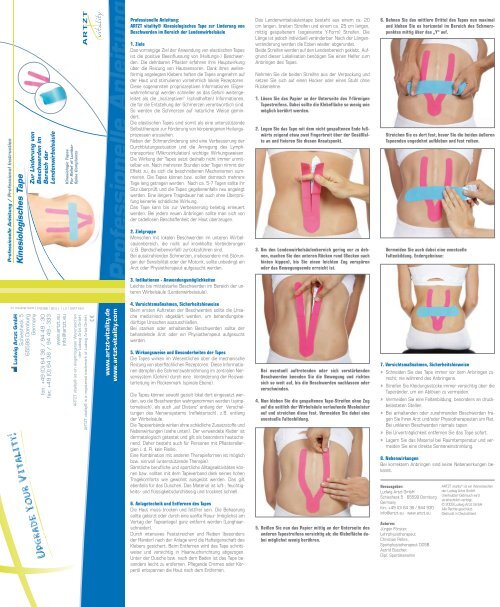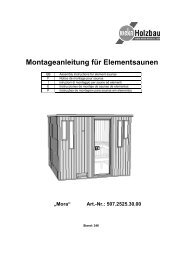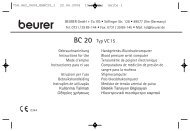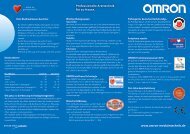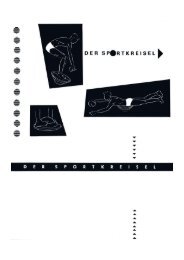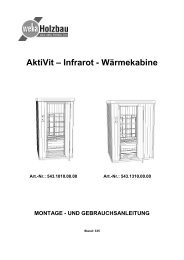Anleitung für das ARTZT vitality® Kinesiologisches Tape ...
Anleitung für das ARTZT vitality® Kinesiologisches Tape ...
Anleitung für das ARTZT vitality® Kinesiologisches Tape ...
Erfolgreiche ePaper selbst erstellen
Machen Sie aus Ihren PDF Publikationen ein blätterbares Flipbook mit unserer einzigartigen Google optimierten e-Paper Software.
Professionelle <strong>Anleitung</strong> / Professional Instruction<br />
<strong>Kinesiologisches</strong> <strong>Tape</strong><br />
KIN.LWS | V1 | 1109 | 98054 | www.attentio.cc<br />
Ludwig Artzt GmbH<br />
Schiesheck 5<br />
65599 Dornburg<br />
Germany<br />
upgrade your vitality!<br />
Zur Linderung von<br />
Beschwerden im<br />
Bereich der<br />
Lendenwirbelsäule<br />
fon: +49 (0) 64 36 / 94 49 - 30<br />
fax: +49 (0) 64 36 / 94 49 - 333<br />
www.artzt.eu<br />
info@artzt.eu<br />
Kinesiologic <strong>Tape</strong>s<br />
For Relief of Lumbar<br />
Spine Complaints<br />
<strong>ARTZT</strong> <strong>vitality®</strong> ist ein eingetragenes Warenzeichen<br />
der Ludwig Artzt GmbH.<br />
<strong>ARTZT</strong> <strong>vitality®</strong> is a registered trademark of Ludwig Artzt GmbH.<br />
Übungsanle<br />
Professionelle <strong>Anleitung</strong><br />
www.artzt-vitality.de<br />
www.artzt-vitality.com<br />
Professionelle <strong>Anleitung</strong>:<br />
<strong>ARTZT</strong> <strong>vitality®</strong> <strong>Kinesiologisches</strong> <strong>Tape</strong> zur Linderung von<br />
Beschwerden im Bereich der Lendenwirbelsäule<br />
1. Ziele<br />
Das vorrangige Ziel der Anwendung von elastischen <strong>Tape</strong>s<br />
ist die positive Beeinflussung von (Haltungs-) Beschwerden.<br />
Die dehnbaren Pflaster erfahren ihre Hauptwirkung<br />
über die Reizung von Hautsensoren. Dank ihres wellenförmig<br />
angelegten Klebers haften die <strong>Tape</strong>s angenehm auf<br />
der Haut und stimulieren vornehmlich lokale Rezeptoren.<br />
Diese sogenannten propriozeptiven Informationen (Eigenwahrnehmung)<br />
werden schneller an <strong>das</strong> Gehirn weitergeleitet<br />
als die „nozizeptiven“ (schadhaften) Informationen,<br />
die <strong>für</strong> die Entstehung der Schmerzen verantwortlich sind.<br />
So werden die Schmerzen auf natürliche Weise gemindert.<br />
Die elastischen <strong>Tape</strong>s sind somit als eine unterstützende<br />
Selbsttherapie zur Förderung von körpereigenen Heilungsprozessen<br />
anzusehen.<br />
Neben der Schmerzlinderung sind eine Verbesserung der<br />
Durchblutungssituation und die Anregung des Lymphtransportes<br />
(Mikrozirkulation) wichtige Wirkungsweisen.<br />
Die Wirkung der <strong>Tape</strong>s setzt deshalb nicht immer unmittelbar<br />
ein. Nach mehreren Stunden oder Tagen nimmt der<br />
Effekt zu, da sich die beschriebenen Mechanismen summieren.<br />
Die <strong>Tape</strong>s können bzw. sollen demnach mehrere<br />
Tage lang getragen werden. Nach ca. 5-7 Tagen sollte ihr<br />
Sitz überprüft und die <strong>Tape</strong>s gegebenenfalls neu angelegt<br />
werden. Eine längere Tragedauer hat auch ohne Überprüfung<br />
keinerlei schädliche Wirkung.<br />
Das <strong>Tape</strong> kann bis zur Verbesserung beliebig erneuert<br />
werden. Bei jedem neuen Anbringen sollte man sich von<br />
der tadellosen Beschaffenheit der Haut überzeugen.<br />
2. Zielgruppe<br />
Menschen mit lokalen Beschwerden im unteren Wirbelsäulenbereich,<br />
die nicht auf krankhafte Veränderungen<br />
(z.B. Bandscheibenvorfall) zurückzuführen sind.<br />
Bei ausstrahlenden Schmerzen, insbesondere mit Störungen<br />
der Sensibilität oder der Motorik, sollte unbedingt ein<br />
Arzt oder Physiotherapeut aufgesucht werden.<br />
3. Indikationen - Anwendungsmöglichkeiten<br />
Leichte bis mittelstarke Beschwerden im Bereich der unteren<br />
Wirbelsäule (Lendenwirbelsäule).<br />
4. Vorsichtsmaßnahmen, Sicherheitshinweise<br />
Beim ersten Auftreten der Beschwerden sollte die Ursache<br />
medizinisch abgeklärt werden, um behandlungsbedürftige<br />
Ursachen auszuschließen.<br />
Bei starken oder anhaltenden Beschwerden sollte der<br />
behandelnde Arzt oder ein Physiotherapeut aufgesucht<br />
werden.<br />
5. Wirkungsweise und Besonderheiten der <strong>Tape</strong>s<br />
Die <strong>Tape</strong>s wirken im Wesentlichen über die mechanische<br />
Reizung von oberflächlichen Rezeptoren. Diese Informationen<br />
dämpfen die Schmerzwahrnehmung im zentralen Nervensystem<br />
(Gehirn) durch eine Veränderung der Reizweiterleitung<br />
im Rückenmark (spinale Ebene).<br />
Die <strong>Tape</strong>s können sowohl gezielt lokal dort eingesetzt werden,<br />
wo die Beschwerden wahrgenommen werden (symptomatisch),<br />
als auch „auf Distanz“ entlang der Verschaltungen<br />
des Nervensystems (reflektorisch), z.B. entlang<br />
der Wirbelsäule.<br />
Die <strong>Tape</strong>verbände wirken ohne schädliche Zusatzstoffe und<br />
Nebenwirkungen (siehe unten). Der verwendete Kleber ist<br />
dermatologisch getestet und gilt als besonders hautschonend.<br />
Daher besteht auch <strong>für</strong> Personen mit Pflasterallergien<br />
i. d. R. kein Risiko.<br />
Eine Kombination mit anderen Therapieformen ist möglich<br />
bzw. sinnvoll (unterstützende Therapie).<br />
Sämtliche berufliche und sportliche Alltagsaktivitäten können<br />
bzw. sollten mit dem <strong>Tape</strong>verband dank seines hohen<br />
Tragekomforts wie gewohnt ausgeübt werden. Das gilt<br />
ebenfalls <strong>für</strong> <strong>das</strong> Duschen. Das Material ist luft-, feuchtigkeits-<br />
und flüssigkeitsdurchlässig und trocknet schnell.<br />
6. Anlagetechnik und Entfernen des <strong>Tape</strong>s<br />
Die Haut muss trocken und fettfrei sein. Die Behaarung<br />
sollte gekürzt oder durch eine sanfte Rasur (möglichst am<br />
Vortag der <strong>Tape</strong>anlage) ganz entfernt werden (Langhaarschneider).<br />
Durch intensives Feststreichen und Reiben (besonders<br />
der Ränder) nach der Anlage wird die Hafteigenschaft des<br />
Klebers gesichert. Beim Entfernen wird <strong>das</strong> <strong>Tape</strong> schrittweise<br />
und vorsichtig in Haarwuchsrichtung abgezogen.<br />
Unter der Dusche bzw. nach dem Baden ist <strong>das</strong> <strong>Tape</strong> besonders<br />
leicht zu entfernen. Pflegende Cremes oder Körperöl<br />
entspannen die Haut nach dem Entfernen.<br />
Das Lendenwirbelsäulentape besteht aus einem ca. 20<br />
cm langen, breiten Streifen und einem ca. 25 cm langen,<br />
mittig gespaltenem (sogenannte Y-Form) Streifen. Die<br />
Länge ist jedoch individuell veränderbar. Nach der Längenveränderung<br />
werden die Ecken wieder abgerundet.<br />
Beide Streifen werden auf den Lendenbereich geklebt. Aufgrund<br />
dieser Lokalisation benötigen Sie einen Helfer zum<br />
Anbringen des <strong>Tape</strong>s.<br />
Nehmen Sie die beiden Streifen aus der Verpackung und<br />
setzen Sie sich auf einen Hocker oder einen Stuhl ohne<br />
Rückenlehne.<br />
1. Lösen Sie <strong>das</strong> Papier an der Unterseite des Y-förmigen<br />
<strong>Tape</strong>streifens. Dabei sollte die Klebefläche so wenig wie<br />
möglich berührt werden.<br />
2. Legen Sie <strong>das</strong> <strong>Tape</strong> mit dem nicht gespaltenen Ende fußwärts<br />
zeigend etwa zwei Fingerbreit über der Gesäßfalte<br />
an und fixieren Sie diesen Ansatzpunkt.<br />
3. Um den Lendenwirbelsäulenbereich gering vor zu dehnen,<br />
machen Sie den unteren Rücken rund (Becken nach<br />
hinten kippen), bis Sie einen leichten Zug verspüren<br />
oder <strong>das</strong> Bewegungsende erreicht ist.<br />
Bei eventuell auftretenden oder sich verstärkenden<br />
Beschwerden beenden Sie die Bewegung und richten<br />
sich so weit auf, bis die Beschwerden nachlassen oder<br />
verschwinden.<br />
4. Nun kleben Sie die gespaltenen <strong>Tape</strong>-Streifen ohne Zug<br />
auf die seitlich der Wirbelsäule verlaufende Muskulatur<br />
auf und streichen diese fest. Vermeiden Sie dabei eine<br />
eventuelle Faltenbildung.<br />
5. Reißen Sie nun <strong>das</strong> Papier mittig an der Unterseite des<br />
anderen <strong>Tape</strong>streifens vorsichtig ab; die Klebefläche dabei<br />
möglichst wenig berühren.<br />
6. Dehnen Sie <strong>das</strong> mittlere Drittel des <strong>Tape</strong>s nun maximal<br />
und kleben Sie es horizontal im Bereich des Schmerzpunktes<br />
mittig über <strong>das</strong> „Y“ auf.<br />
Streichen Sie es dort fest, bevor Sie die beiden äußeren<br />
<strong>Tape</strong>enden ungedehnt aufkleben und fest reiben.<br />
Vermeiden Sie auch dabei eine eventuelle<br />
Faltenbildung. Endergebnisse:<br />
7. Vorsichtsmaßnahmen, Sicherheitshinweise<br />
» Schneiden Sie <strong>das</strong> <strong>Tape</strong> immer vor dem Anbringen zurecht;<br />
nie während des Anbringens.<br />
» Streifen Sie Kleidungsstücke immer vorsichtig über die<br />
<strong>Tape</strong>ränder, um ein Ablösen zu vermeiden.<br />
» Vermeiden Sie eine Faltenbildung; besonders an druckbelasteten<br />
Stellen.<br />
» Bei anhaltenden oder zunehmenden Beschwerden fragen<br />
Sie Ihren Arzt und/oder Physiotherapeuten um Rat.<br />
Bei unklaren Beschwerden niemals tapen.<br />
» Bei Unverträglichkeit entfernen Sie <strong>das</strong> <strong>Tape</strong> sofort.<br />
» Lagern Sie <strong>das</strong> Material bei Raumtemperatur und vermeiden<br />
Sie eine direkte Sonneneinstrahlung.<br />
8. Nebenwirkungen<br />
Bei korrektem Anbringen sind keine Nebenwirkungen bekannt.<br />
Herausgeber:<br />
Ludwig Artzt GmbH<br />
Schiesheck 5 ∙ 65599 Dornburg<br />
Germany<br />
fon: +49 (0) 64 36 / 944 930<br />
info@artzt.eu ∙ www.artzt.eu<br />
Autoren:<br />
Jürgen Förster,<br />
Lehrphysiotherapeut<br />
Christian Röhrs,<br />
Sportphysiotherapeut DOSB<br />
Astrid Buscher,<br />
Dipl. Sportökonomin<br />
<strong>ARTZT</strong> vitality ® ist ein Warenzeichen<br />
der Ludwig Artzt GmbH.<br />
Unerlaubter Gebrauch wird<br />
strafrechtlich verfolgt.<br />
© 2009 Ludwig Artzt GmbH.<br />
Alle Rechte geschützt.<br />
Gedruckt in Deutschland.
Professional Instruction:<br />
<strong>ARTZT</strong> <strong>vitality®</strong> Kinesiologic <strong>Tape</strong>s for Relief of<br />
Lumbar Spine Complaints<br />
1. Objectives<br />
The main objective of the application of elastic tapes is to<br />
positively influence (postural) complaints. The main effect<br />
of the elastic tapes is to stimulate skin sensors. Thanks<br />
to their adhesive which is applied in a wavy pattern, the<br />
tapes adhere pleasantly to the skin and mainly stimulate<br />
local receptors. This so-called proprioceptive information<br />
(self-perception) is passed on to the brain more quickly<br />
than the “nociceptive” (harmful) information that is responsible<br />
for causing pain. Pain is thereby reduced in a<br />
natural manner.<br />
Therefore, the tapes should be viewed as supportive selftherapy<br />
to promote the body’s own healing processes.<br />
In addition to pain relief, important effects include improved<br />
blood circulation and the stimulation of lymph transportation<br />
(micro-circulation). This is why the tapes are<br />
not always effective immediately. After several hours or<br />
days, their effectiveness increases since the mechanisms<br />
described above come together. Therefore the tapes can<br />
and should be worn for several days. After approximately<br />
5-7 days, their position should be examined and the tapes<br />
should be reapplied if necessary. More extended wear has<br />
no harmful consequences, even without examination.<br />
The tapes can be replaced as often as desired until the<br />
condition improves. Verifying that the skin is sound and<br />
unbroken is recommended prior to each application.<br />
2. Target group<br />
People with localised complaints in the spine region that<br />
are not caused by abnormal changes (e.g. herniated<br />
discs).<br />
In case of radiating pain, especially in combination with<br />
sensitivity or motor disturbances, consulting a doctor or<br />
physiotherapist is highly recommended.<br />
3. Indications – areas of application<br />
Mild to moderate complaints in the area of the lower spine<br />
(lumbar spine).<br />
4. Precautions, safety information<br />
When the complaint is first noticed, the cause should be<br />
examined medically in order to exclude the possibility of<br />
causes that require medical treatment.<br />
The attending doctor or a physiotherapist should be consulted<br />
in case of severe or long-term complaints.<br />
5. Effect and particularities of the tapes<br />
The main effect of the tapes is the mechanical stimulation<br />
of surface receptors. This information dampens<br />
pain perception in the central nervous system (brain) by<br />
modifying the transmission of stimuli in the spinal cord<br />
(spinal level).<br />
The tapes can be used locally in a targeted manner at the<br />
location where the pain is perceived (symptomatic) and<br />
also “at a distance” along the pathways of the nervous<br />
system (reactive), e.g. along the spinal cord.<br />
The tapes do not contain harmful additives and there are<br />
no known side effects (see below). The adhesive that is<br />
used has been dermatologist tested and is considered especially<br />
skin-friendly. This is why there is also normally no<br />
risk for persons allergic to conventional plasters.<br />
Combinations with other types of therapy are possible and<br />
/ or recommended (supporting therapy).<br />
Thanks to the high level of wearer comfort of the tapes, all<br />
day-to-day work and sports activities can and / or should<br />
be conducted as usual with the tapes in place. The same<br />
applies to showering. The material is breathable, permeable<br />
to moisture and liquids and dries quickly.<br />
6. Application method and removal of the tapes<br />
The skin must be dry and free of grease. Hair should be<br />
trimmed (long-hair trimmer) or gently removed entirely by<br />
shaving (if possible, the day before applying the tapes).<br />
Intensively pressing the tapes in place and rubbing (especially<br />
along the edges) after application ensures the adhesive<br />
will adhere properly.<br />
To remove the tapes, carefully and gradually pull in the<br />
direction of hair growth. The tapes are especially easy to<br />
remove in the showering. Skin cream or body oil help relax<br />
the skin after removing the tapes.<br />
The lumbar spine tapes consists of a wide strip with a<br />
length of approximately 20 cm and a strip with a length of<br />
approximately 25 cm that is split in the middle (so-called<br />
Y shape). However, the length is individually adjustable.<br />
After adjusting the length, the edges have to be rounded<br />
again. Both strips are applied to the lumbar region.<br />
Because of this positioning, you need a helper in order to<br />
apply the tapes.<br />
Take both strips out of the package and sit down on a stool<br />
or a chair without a backrest.<br />
1) Remove the backing paper from the Y-shaped tape strip.<br />
Avoid touching the adhesive surface during this process.<br />
2) With the end that is not split facing down towards your<br />
feet, apply the bottom end of the tape approximately two<br />
finger widths above the gluteal cleft and secure this<br />
starting point<br />
3) In order to slightly extend the lumbar spine region,<br />
round your lower back (tilt the pelvis backwards) until<br />
you feel slight tension or reach the limit of your range of<br />
motion.<br />
If you experience discomfort or the level of existing discomfort<br />
increases, stop the movement and straighten<br />
up until the level of discomfort decreases or the feeling<br />
goes away.<br />
4) Now apply the split tape strips to the musculature on<br />
both sides of the spine without tension and press them<br />
into place. Make sure no folds or ripples form in the<br />
process.<br />
5) Now carefully tear off the backing paper in the middle<br />
of the other tape strip. Avoid touching the adhesive surface<br />
during this process.<br />
6) Stretch the centre one-third of the tape as far as possible<br />
and apply it horizontally in the area where pain is<br />
felt, centred over the “Y”<br />
Press it into place before you apply the two outside ends<br />
of the tape without tension and press them down<br />
Once again, make sure no folds or ripples form in the<br />
process.<br />
7. Precautions, safety information<br />
» Always cut the tapes to size prior to application, never<br />
while you are applying them.<br />
» Always be careful when pulling clothing over the edges<br />
of the tapes; avoid loosening the tapes.<br />
» Avoid the formation of folds and ripples, especially where<br />
they could cause pressure.<br />
» If your complaints persist or worsen, consult your doctor<br />
and / or physiotherapist. Never apply the tapes if<br />
your complaints have not been diagnosed.<br />
» Remove the tapes immediately in case of intolerance.<br />
» Store the material at room temperature and avoid direct<br />
exposure to sunlight.<br />
8. Side effects<br />
There are no known side effects with correct application.<br />
Publisher:<br />
Ludwig Artzt GmbH<br />
Schiesheck 5 ∙ 65599 Dornburg<br />
Germany<br />
fon: +49 (0) 64 36 / 944 930<br />
info@artzt.eu ∙ www.artzt.eu<br />
Authors:<br />
Jürgen Förster,<br />
Lehrphysiotherapeut<br />
Christian Röhrs,<br />
Sportphysiotherapeut DOSB<br />
Astrid Buscher,<br />
Dipl. Sportökonomin<br />
<strong>ARTZT</strong> <strong>vitality®</strong> is a registered<br />
trademark of Ludwig Artzt<br />
GmbH.Unauthorized use is<br />
strictly prohibited.© 2009<br />
Ludwig Artzt GmbH.<br />
All rights reserved.<br />
Printed in Germany.


